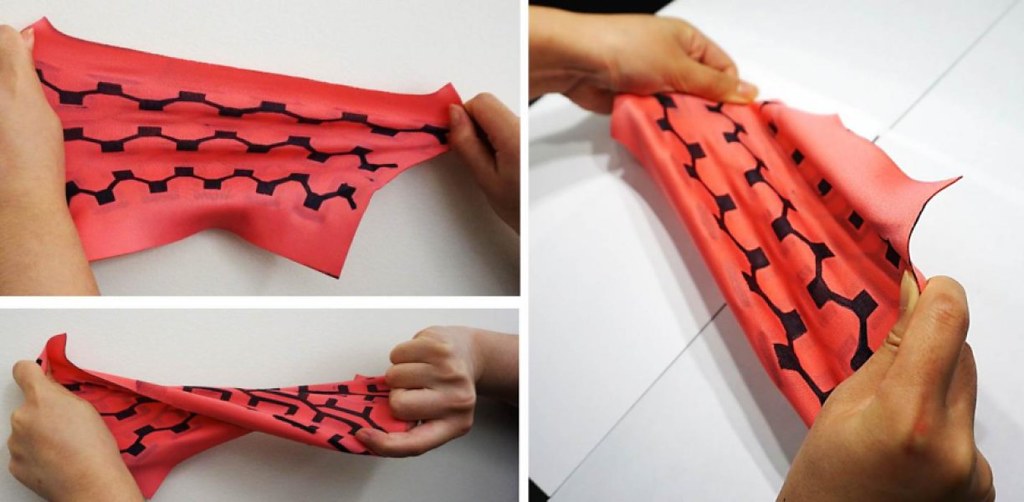未來人們有機會用衣服幫各種隨身電子用品充電。紐約州立大學賓漢頓分校的研究團隊開發出一種以織品為基礎、靠細菌發電的「紡織生物電池」,可以與穿戴式電子設備整合,重複拉扯和扭轉測試時仍可展現穩定的發電能力。

研究主持人賓漢頓分校電機系助理教授Seokheun Choi表示,這種可伸縮、可扭轉的動力裝置可以為紡織生物電池建立一個標準化的平台,「市場迫切需要可彈性伸縮、可輕鬆與各種環境整合以收集即時訊息的電子設備。這些電子設備必須能在複雜和不規則形狀的基板上可靠運作,包括移動中的身體部位或器官。」
「我們認為可彈性伸縮的小型生物電池是真正實用的能源技術,因為它們永續、可再生且環保。」Choi說。
人體的汗水可以作為細菌的燃料,讓織品生物電池中的微生物燃料單電池可以長時間運作。Choi說,與傳統的電池和其他酵素燃料電池相比,微生物燃料電池更適合用於穿戴電子產品,因為用整個微生物細胞當作生物催化劑可以提供穩定的酵素反應和較長的使用壽命。
今年3月,Choi和他的團隊創造出第一個微型自給自足單電池,透過兩種細菌的共生連續發電了13天。「這個利用協同作用發電的概念並不新鮮。不過開發上仍處於初始階段。」Choi說。
研究人員在一個大約1/5茶匙大小的培養室中放置光營和異營細菌的混合培養物。光營細菌利用陽光、二氧化碳和水來製造能量,而異營細菌必須以有機物或光營菌為食。
當培養室暴露在陽光下時,研究人員將作用最初期的「食物」加入培養室中以刺激異營細菌的生長。通過細胞呼吸,異營細菌產生二氧化碳廢物,啟動光養菌的共生循環。
建立起共生週期後,研究人員不再為異營菌添加額外的食物來源,並且會有足夠的光營菌來維持異營菌的代謝過程。
這些代謝過程產生了每平方公分8微安培的電流,並持續13天。這個功率是光營菌產生單獨產生的電流的約70倍。
「以異營菌為基礎的燃料電池能產生更高的功率,而光合微生物燃料電池提供自我維持能力。這是目前為止最兩全其美的組合。」Choi說。
這種微生物燃料電池可運用於偏遠地區或危險場所的低功耗裝置(如健康監測器和基礎設施診斷傳感器)。
這項研究發表於《先進能源材料》(Advanced Energy Materials)期刊。
In the future, people could wear garments that incorporate power-generating bacteria to support electronic devices. A textile-based, bacteria-powered bio-battery that can be integrated into wearable electronics has been created by a research team at Binghamton University, State University of New York.
Led by Binghamton University Electrical and Computer Science Assistant Professor Seokheun Choi, the team has developed a textile-based bio-battery that exhibits stable electricity-generating capability when tested under repeated stretching and twisting cycles.
Choi said that this stretchable, twistable power device could establish a standardized platform for textile-based bio-batteries and could be integrated into wearable electronics in the future.
“There is a clear and pressing need for flexible and stretchable electronics that can be easily integrated with a wide range of surroundings to collect real-time information,” said Choi.
“Those electronics must perform reliably even while intimately used on substrates with complex and curvilinear shapes, like moving body parts or organs,” he said.
“We considered a flexible, stretchable, miniaturized bio-battery as a truly useful energy technology because of their sustainable, renewable and eco-friendly capabilities,” said Choi.
Sweat generated from the human body can act as a fuel to support bacterial viability, providing the long-term operation of the microbial fuel cells that make up the fabric bio-battery.
Compared to traditional batteries and other enzymatic fuel cells, microbial fuel cells can be the most suitable power source for wearable electronics because using whole microbial cells as a biocatalyst provides stable enzymatic reactions and a long lifetime, said Choi.
In March, Choi and his team published a paper on their creation of the first micro-scale self-sustaining cell, which generated power for 13 straight days through the symbiotic interactions of two types of bacteria.
“This concept of creating electricity through synergistic cooperation is not new. However, much of this work is still in its nascent stages,” said Choi.
In a cell chamber about one-fifth the size of a teaspoon, researchers placed a mixed culture of phototrophic and heterotrophic bacteria.
Phototrophic bacteria use sunlight, carbon dioxide, and water to make their own energy, while heterotrophic bacteria must feed on provided organic matter or phototrophic bacteria to survive.
While the cell was exposed to sunlight, an initial dose of “food” was added to the chamber to stimulate growth of the heterotrophic bacteria. Through cellular respiration, the heterotrophic bacteria produced carbon dioxide waste, which was used by the phototrophic bacteria to kickstart the symbiotic cycle.
After that cycle was established, researchers stopped adding additional food sources for the heterophic bacteria, and there were enough phototrophic bacteria to sustain the metabolic processes of the heterophic bacteria.
Those metabolic processes generated an electrical current – eight microamps per square centimeter of cell – for 13 straight days. The power was about 70 times greater than current produced by phototrophic bacteria alone.
“Heterotrophic bacteria-based fuel cells generate higher power, while photosynthetic microbial fuel cells provide self-sustainability. This is the best of both worlds, thus far,” said Choi.
These microbial fuel cells could be used to provide power in remote or dangerous locations for low-power items such as health monitors and infrastructure diagnostic sensors.
※ 全文及圖片詳見:ENS








